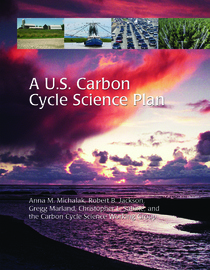Carbon Cycle Science Plan
Scientists Tackle the Carbon Conundrum
"A U.S. Carbon Cycle Science Plan" was commissioned by the United States Carbon Cycle Science Program and published by the University Corporation for Atmospheric Research
U.S. scientists have developed a new, integrated, ten-year science plan to better understand the details of Earth’s carbon cycle and people’s role in it. Understanding the carbon cycle is central for mitigating climate change and developing a sustainable future. The plan builds on the first such plan, published in 1999, but identifies new research areas such as the role of humans as agents and managers of carbon cycling and climate change, the direct impact of greenhouse gases on ecosystems including changes to the diversity of plants and animals and ocean acidification, the need to address social concerns, and how best to communicate scientific results to the public and decision makers.
The 1999 science plan resulted in numerous breakthroughs for understanding the carbon cycle and how it is changing in response to human pressures. For instance, researchers discovered that the huge quantities of CO2 absorbed by the oceans are causing ocean acidification, which is harming sea life and affecting the food chain. Research also characterized the large uptake of carbon by plants and soils in the Northern Hemisphere, and found that understanding land use and disturbance patterns is integral to understanding the global carbon cycle.
The new plan extents the focus to new questions. For instance, it emphasizes that humans are an integral part of the global carbon cycle, and includes research into the factors and processes of humans interacting with the physical Earth systems.
The plan is the culmination of a three-year effort with input from hundreds of scientists about the current needs of the research community. Carnegie Institution for Science’s Anna Michalak, Duke University’s Rob Jackson, Appalachian State University’s Gregg Marland, and the National Oceanic and Atmospheric Administration’s Christopher Sabine led the work on the 2011 A U.S. Carbon Cycle Science Plan.
The team developed four science elements to drive the research. The backbone of the research strategy is to strengthen the network of observations to better monitor and track carbon as it winds its way through the atmosphere, ecosystems, oceans and society, and to find out how this changes over time. Other elements include studies of the processes that control the flows and transformations of carbon, and developing numerical models to predict future behavior.
Another important aspect of the plan is its increased emphasis on communication and making research more accessible to policy makers and the general public to make rational and well-informed decisions on how best to manage the global carbon cycle, especially the human impacts on it.
In an era of tight budgets and with public questions about the value of science, this plan calls for an expanded role for careful, integrated, and clear science to inform and support human objectives for a sustainable environment.


